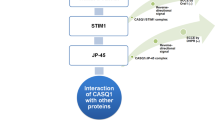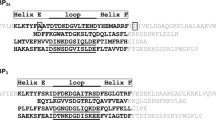Summary
Calreticulin was identified in a variety of rabbit tissues by Western blot analysis. Indirect immunofluorescence studies on cultured cells or frozen sections from the corresponding tissues revealed that the protein was distributed to the endoplasmic reticulum or sarcoplasmic reticulum. Calreticulin was found to be an abundant calcium-binding protein in non-muscle and smooth muscle cells and a constitutent calcium-binding protein in cardiac and skeletal muscle. From the immunoblot data, calreticulin may exist as an isoform in rabbit neural retina. The present study establishes the ubiquity of calreticulin in intracellular calcium binding.
Similar content being viewed by others
References
Baksh S, Michalak M (1991) Expression of calreticulin in Escherichia coli and identification of its Ca2+ binding domains. J Biol Chem 266:21458–21465
Bradford MM (1976) A rapid and sensitive method for the quantitation of microgram quantities of protein utilizing the principle of protein-dye binding. Anal Biochem 72:248–254
Breemen C van, Saida K (1989) Cellular mechanisms regulating [Ca2+]i smooth muscle. Annu Rev Physiol 51:315–329
Carafoli E (1987) Intracellular calcium homeostasis. Annu Rev Biochem 56:395–433
Fleischer S, Inui M (1989) Biochemistry and biophysics of excitation-contraction coupling. Annu Rev Biophys Biophys Chem 18:333–364
Fliegel L, Ohnishi M, Carpenter MR, Khanna VK, Reithmeier RAF, MacLennan DH (1987) Amino acid sequence of rabbit fast-twitch skeletal muscle calsequestrin deduced from cDNA and peptide sequencing. Proc Natl Acad Sci USA 84:1167–1171
Fliegel L, Burns K, Opas M, Michalak M (1989a) The high-affinity calcium binding protein of sarcoplasmic reticulum. Tissue distribution, and homology with calregulin. Biochim Biophys Acta 982:1–8
Fliegel L, Burns K, MacLennan DH, Reithmeier RAF, Michalak M (1989b) Molecular cloning of the high affinity calcium-binding protein (calreticulin) of skeletal muscle sarcoplasmic reticulum. J Biol Chem 264:21522–21528
Hashimoto S, Bruno B, Lew DP, Pozzan T, Volpe P, Meldolesi J (1988) Immunocytochemistry of calciosomes in liver and pancreas. J Cell Biol 107:2523–2531
Krause K-H, Chou M, Thomas MA, Sjolund RD, Campbell KP (1989) Plant cells contain calsequestrin. J Biol Chem 264:4269–4272
Kretsinger RH, Nockolds CE (1973) Carp muscle calcium binding protein II. Structure determination and general description. J Biol Chem 248:3313–3326
Laemmli UK (1970) Cleavage of structural proteins during the assembly of the head of bacteriophage T4. Nature 227:680–685
Leffert HL, Koch KS, Moran T, Williams M (1979) Liver cells. In: Jakoby WB, Pastan IH (eds) Methods in enzymology, vol LVIII. Academic Press, New York, pp 536–544
MacLennan DH, Yip CC, Iles GH, Seeman P (1972) Isolation of sarcoplasmic reticulum proteins. Cold Spring Harbor Symp Quant Biol 37:469–477
MacLennan DH, Campbell KP, Reithmeier RAF (1983) Calsequestrin. In: Cheung WY (ed) Calcium and cell function, vol 4. Academic Press, New York, pp 151–173
McPherson PS, Campbell KP (1990) Solubilization and biochemical characterization of the high affinity [3H]ryanodine receptor from rabbit brain membranes. J Biol Chem 265:18454–18460
McPherson PS, Kim Y-K, Valdivia H, Knudson CM, Takekura H, Franzini-Armstrong C, Coronado R, Campbell KP (1991) The brain ryanodine receptor: a caffeine-sensitive calcium release channel. Neuron 7:17–25
Meldolesi J, Madeddu L, Pozzan T (1990) Intracellular Ca2+ storage organelles in non-muscle cells: heterogeneity and functional assignment. Biochim Biophys Acta 1055:130–140
Michalak M, MacLennan DH (1980) Assembly of the sarcoplasmic reticulum. Biosynthesis of the high affinity calcium binding protein in rat skeletal muscle cell cultures. J Biol Chem 255:1327–1334
Michalak M, Campbell KP, MacLennan DH (1980) Localization of the high affinity calcium binding protein and an intrinsic glycoprotein in sarcoplasmic reticulum membranes. J Biol Chem 255:1317–1326
Michalak M, Baksh S, Burns K, Milner RE, Opas M (1990) Calreticulin, a Ca2+-binding protein of sarcoplasmic and endoplasmic reticulum membranes. In: Marechal G, Carraro U (eds) Muscle and motility, vol 2. Intercept, Andover, UK, pp 15–21
Michalak M, Baksh S, Opas M (1991) Identification and immunolocalization of calreticulin in pancreatic cells: no evidence for “calciosomes”. Exp Cell Res 197:91–99
Mignery GA, Südhof TC, Takei K, De Camilli P (1989) Putative receptor for inositol 1,4,5-trisphosphate similar to ryanodine receptor. Nature 342:192–195
Milner RE, Baksh S, Shemanko C, Carpenter MR, Smillie L, Vance JE, Opas M, Michalak M (1991) Calreticulin, and not calsequestrin, is the major calcium binding protein of smooth muscle sarcoplasmic reticulum and liver endoplasmic reticulum. J Biol Chem 266:7155–7165
Opas M, Dziak E (1988) Effects of substrata and method of tissue dissociation on adhesion, cytoskeleton, and growth of chick retinal pigmented epithelium in vitro. In Vitro Cell Dev Biol 24:885–892
Opas M, Dziak E, Fliegel L, Michalak M (1991) Regulation of expression and intracellular distribution of calreticulin, a major calcium binding protein of non muscle cells. J Cell Physiol 149:160–171
Ostwald TJ, MacLennan DH (1974) Isolation of a high affinity calcium-binding protein from sarcoplasmic reticulum. J Biol Chem 249:974–979
Pelham HRB (1989) Control of protein exit from the endoplasmic reticulum. Annu Rev Cell Biol 5:1–23
Perrin D, Sonnichsen B, Soling H, Nguyen-Van P (1991) Purkinje cells of rat and chicken cerebellum contain calreticulin. FEBS Lett 294:47–50
Ross CA, Meldolesi J, Milner TA, Satoh T, Supattapone S, Snyder SH (1989) Inositol 1,4,5-triphosphate receptor localized to endoplasmic reticulum in cerebellar Purkinje neurons. Nature 339:468–470
Rossier MF, Putney JW Jr (1991) The identity of the calcium-storing, inositol 1,4,5-triphosphate-sensitive organelle in nonmuscle cells: calciosome, endoplasmic reticulum...or both? Trends Neurosci 14:310–314
Ryan US, Clements E, Habliston D, Ryan JW (1978) Isolation and culture of pulmonary artery endothelial cells. Tissue Cell 10:535–554
Satoh T, Ross CA, Villa A, Supattapone S, Pozzan T, Snyder SH, Meldolesi J (1990) The inositol 1,4,5-trisphosphate receptor in cerebellar Purkinje cells: quantitative immunogold labeling reveals concentration in an ER subcompartment. J Cell Biol 111:615–624
Scott BT, Simmerman HKB, Collins JH, Nadal-Ginard B, Jones LR (1988) Complete amino acid sequence of canine cardiac calsequestrin deduced by cDNA cloning. J Biol Chem 263:8958–8964
Slupsky JR, Ohnishi M, Carpenter MR, Reithmeier RAF (1987) Characterization of cardiac calsequestrin. Biochemistry 26:6539–6544
Somlyo AP, Himpens B (1989) Cell calcium and its regulation in smooth muscle. FASEB J 3:2266–2276
Towbin H, Staehelin T, Gordon J (1979) Electrophoretic transfer of proteins from polyacrylamide gels to nitrocellulose sheets: procedure and some applications. Proc Natl Acad Sci USA 76:4350–4354
Treves S, De Mattei M, Lanfredi M, Villa A, Green NM, MacLennan DH, Meldolesi J, Pozzan T (1990) Calreticulin is a candidate for a clasequestrin-like function in Ca2+-storage compartments (calciosomes) of liver and brain. Biochem J 271:473–480
Treves S, Zorzato F, Chiozzi P, Melandri P, Volpe P, Pozzan T (1991) Frog brain expresses a 60 kDa Ca2+ binding protein similar to mammalian calreticulin. Biochem Biophys Res Comm 175:444–450
Tsien RW, Tsien RY (1990) Calcium channels, stores, and oscillations. Annu Rev Cell Biol 6:715–760
Van PN, Peter F, Söling H-D (1989) Four intracisternal calcium-binding glycoproteins from rat liver microsomes with high affinity for calcium. J Biol Chem 264:17494–17501
Vaux D, Tooze Y, Fuller S (1990) Identification by anti-idiotype antibodies of an intracellular membrane protein that recognizes a mammalian endoplasmic reticulum retention signal. Nature 345:495–502
Villa A, Podini P, Clegg DO, Pozzan T, Meldolesi J (1991) Intracellular Ca2+ stores in chicken Purkinje neurons: differential distribution of the low affinity-high capacity Ca2+ binding protein, calsequestrin, of Ca2+ ATPase and of the ER lumenal protein. Bip. J Cell Biol 113:779–791
Virtanen I, Ekblom P, Laurila P (1980) Subcellular compartmentalization of saccharide moieties in cultured normal and malignant cells. J Cell Biol 85:429–434
Volpe P, Krause K-H, Hashimoto S, Zorzato F, Pozzan T, Meldolesi J, Lew DP (1988) “Calciosome”, a cytoplasmic organelle: the inositol 1,4,5-trisphosphate-sensitive Ca2+ store of nonmuscle cells? Proc Natl Acad Sci USA 85:1091–1095
Volpe P, Alderson-Lang BH, Madeddu L, Damiani E, Collins JH, Margreth A (1990) Calsequestrin, a component of the inositol 1,4,5-trisphosphate-sensitive Ca2+ store of chicken cerebellum. Neuron 5:713–721
Waisman DM, Salimath BP, Anderson MJ (1985) Isolation and characterization of CAB-63, a novel calcium-binding protein. J Biol Chem 260:1652–1660
Walton PD, Airey JA, Sutko JL, Beck CF, Mignery GA, Sudhof TC, Deerinck TJ, Ellisman MH (1991) Ryanodine and inositol trisphosphate receptors coexist in avian cerebellar Purkinje neurons. J Cell Biol 113:1145–1157
Author information
Authors and Affiliations
Rights and permissions
About this article
Cite this article
Tharin, S., Dziak, E., Michalak, M. et al. Widespread tissue distribution of rabbit calreticulin, a non-muscle functional analogue of calsequestrin. Cell Tissue Res 269, 29–37 (1992). https://doi.org/10.1007/BF00384723
Received:
Accepted:
Issue Date:
DOI: https://doi.org/10.1007/BF00384723




